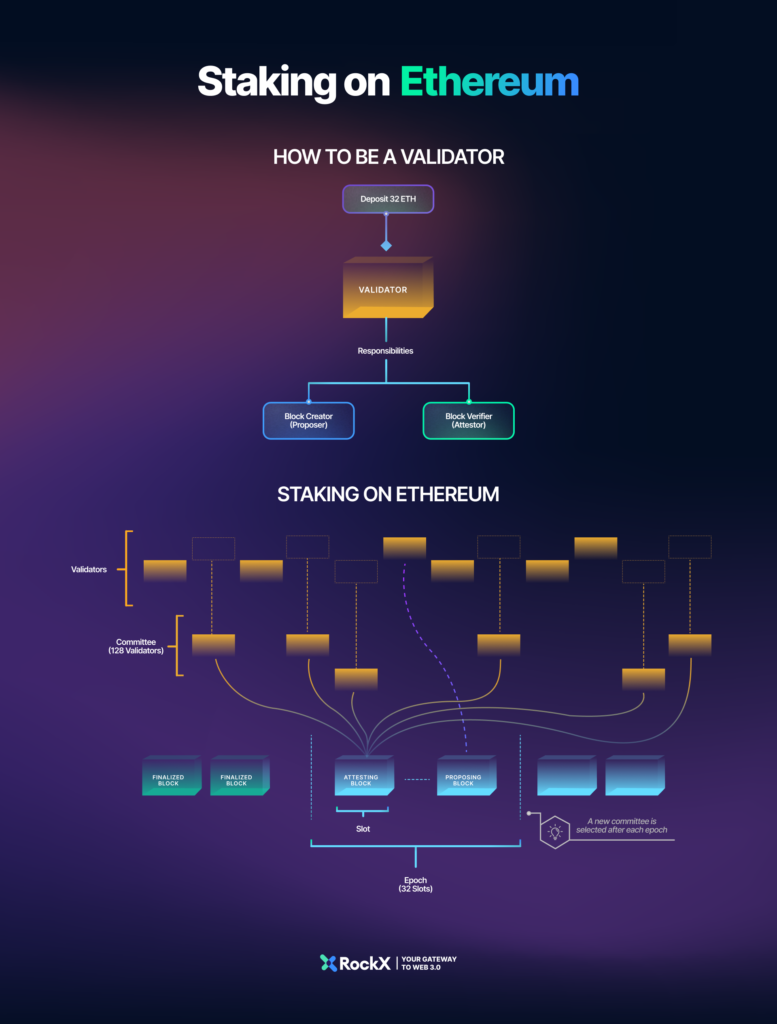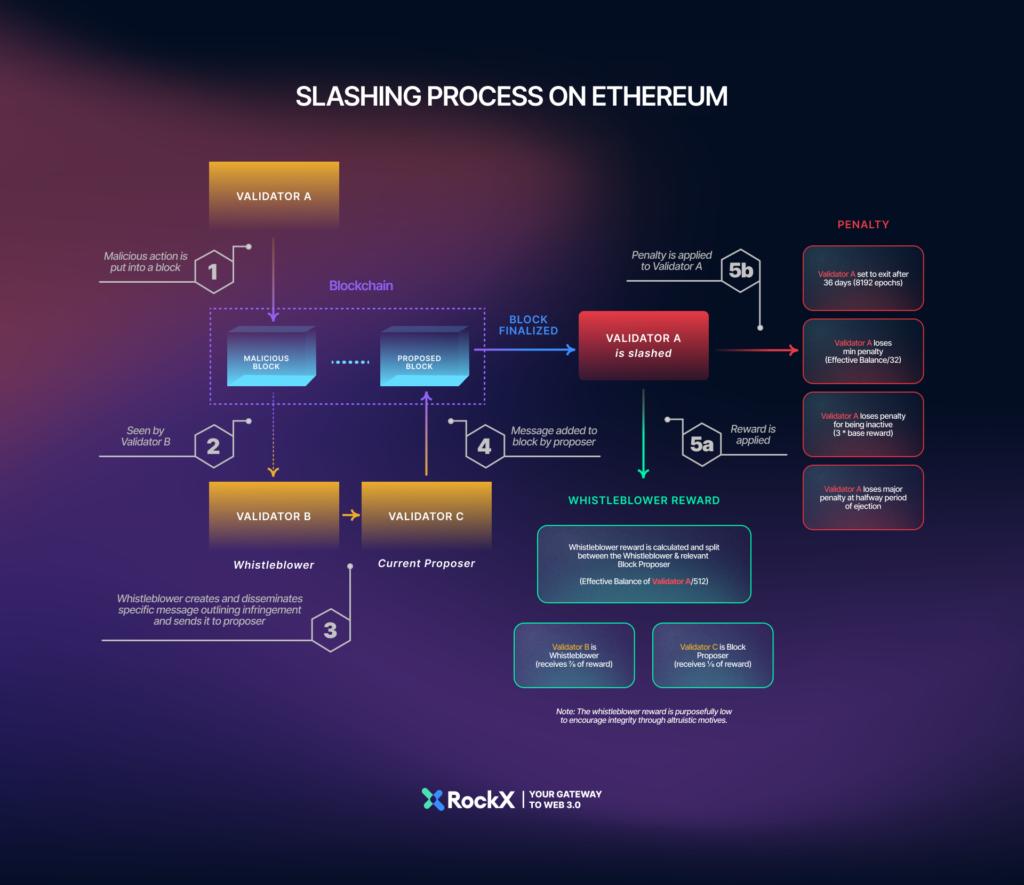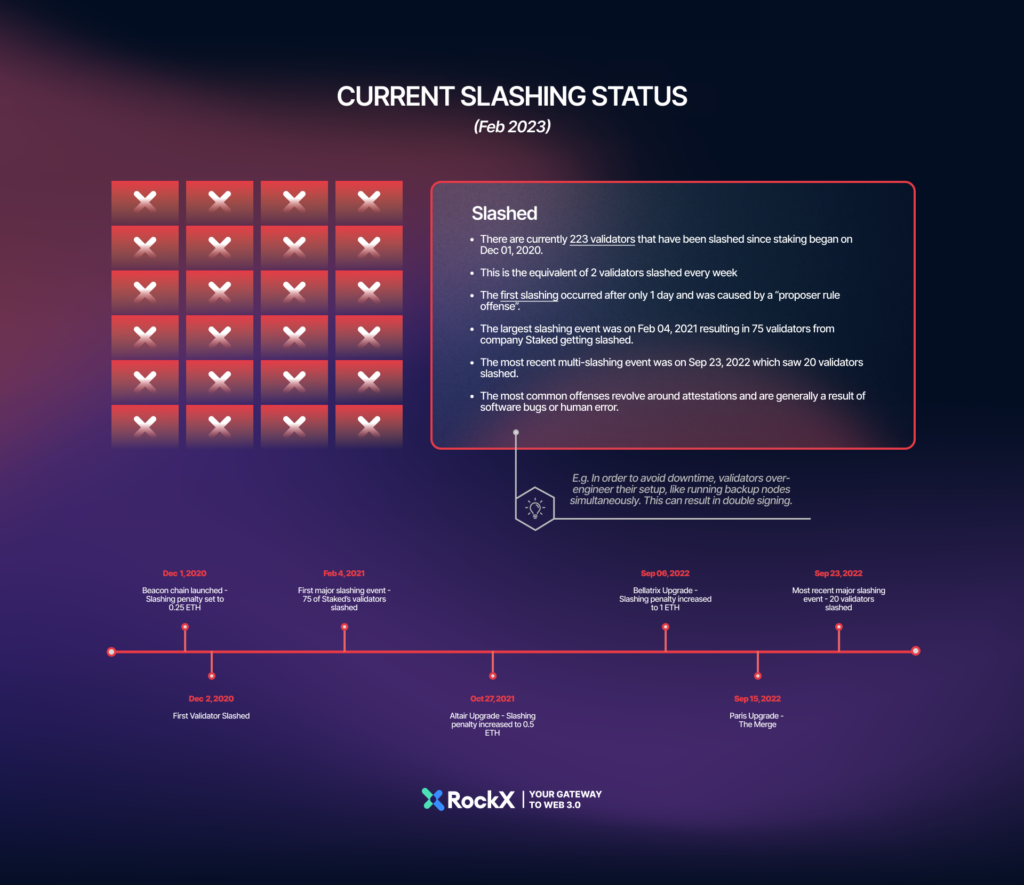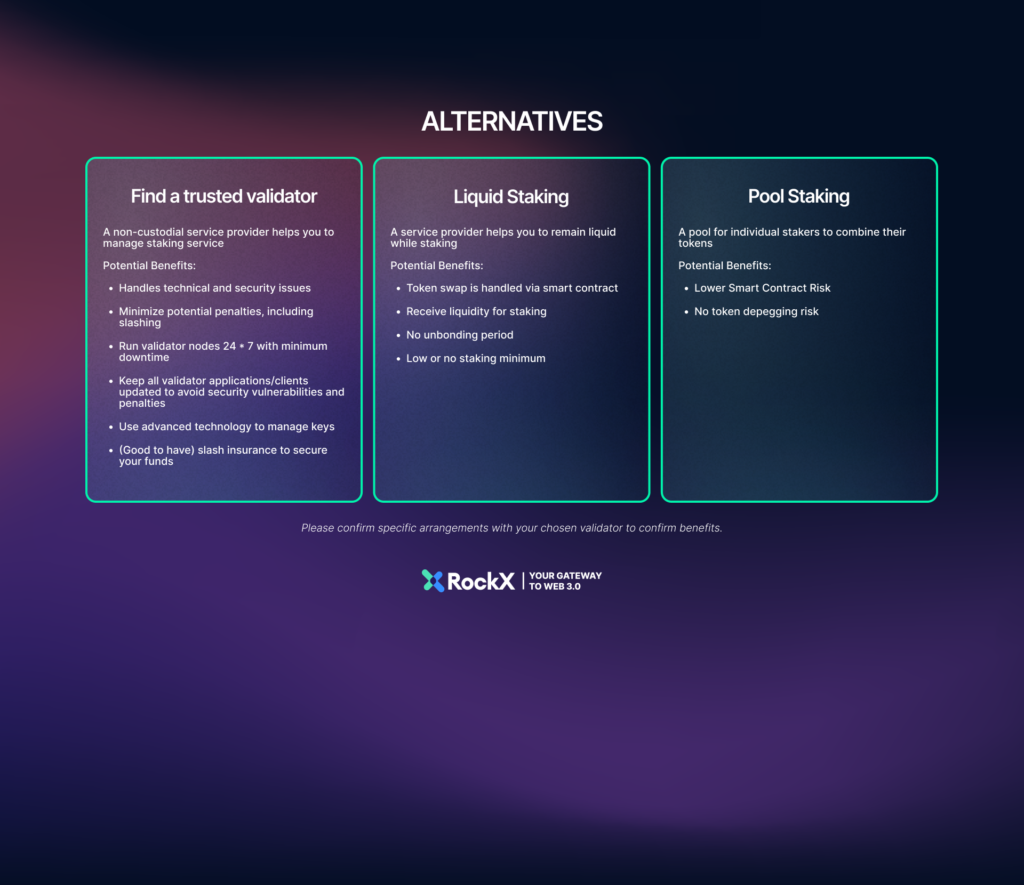In 2020, Ethereum began the process of transitioning to a Proof of Stake (PoS) blockchain. This transition brought on many positive changes to Ethereum, but the most relevant change to this article is the advent of staking on Ethereum. This excited many in the community, but it carried one major risk: slashing. In this article, we’ll go through exactly what slashing on Ethereum is, why it happens, how it happens, and everything else you need to know.
Staking on Ethereum: What’s Happened Since the Merge

Ethereum’s transition to a PoS blockchain allowed users to directly participate in the blockchain as validators. All that was required was 32 ETH, and anyone could become a validator and get selected for one of two responsibilities: a block creator (Proposer) or block verifier (Attestor).
How it works is every epoch (32 blocks), a committee consisting of 128 validators is selected. One validator is the Proposer, and is responsible for proposing a new block, while everyone else is an Attestor, and are responsible for verifying, or attesting, the new block. To clarify, this committee is randomly re-selected after each epoch, which is 32 blocks.

When a validator misbehaves (we’ll get into what constitutes misbehaviour in a bit), they get punished. This could result in either a minor penalty or slashing. Since the Merge, some things have changed. This guide goes through all updated rules, regulations, and penalties to clear things up for everyone.
What is Slashing?

Slashing occurs as a punishment for validators on the blockchain that have misbehaved severely and are deemed to be malicious validators. It is designed to discourage bad actors on the blockchain. For instance, trying to alter block data.
Of course, not every offence is deemed bad enough for slashing, so there are some minor penalties that a validator might unwittingly incur. The two main causes of minor penalties are incorrect attestations (block verifications) or inactivity.
A minor penalty follows the following rules:
- A validator found guilty of an incorrect attestation or inactivity loses an amount equal to the reward if they were online for each epoch.
This amount is increased if multiple validators are offline simultaneously but is decreased as the ETH balance of the validator decreases.
To illustrate, if a validator was supposed to receive 1 ETH as a reward for this epoch but were offline, they will be penalised 1 ETH instead.
However, if three validators were offline for this epoch, they will all be penalised more than 1 ETH, let’s say 2 ETH.
If, of these three validators, one of them has a balance of only 30 ETH (as opposed to 32 ETH), it will be penalised less than 2 ETH, say 1.5 ETH. - Offending validators will be ejected form the network if/when their balance falls to 16 ETH.
Reasons for Slashing

Slashing is a punishment imposed on validators who have committed more serious offences. The three main causes for slashing are:
- Proposing conflicting blocks for a slot (affects a validator that is a Proposer)
- Attesting two blocks with the same target in one epoch (affects a validator that is an Attestor)
- Attesting that surrounds another one conflicting with a previously finalised attestation (affects a validator that is an Attestor)
The above-listed causes for slashing are deemed to be harmful to the Ethereum blockchain, and therefore all the following penalties are triggered upon detection:
- Kicked from the network after 36 days (8192 Epochs)
- Immediately loses minimum penalty of effective balance/32
- Forced to be offline and loses a penalty at the beginning of each Epoch for being inactive at the rate of 3x the base reward
- Loses major penalty halfway through the ‘exit period’ ranging from 1 ETH to the entire balance – the more validators slashed, the higher this penalty
Slashing Process on Ethereum

In this instance, let’s say Validator A is a bad actor and puts a malicious action into a block. Validator B sees this and acts as a whistleblower by creating and disseminating a specific message outlining the witnessed infringement and sends it to the current Proposer, who is Validator C. Validator C, the current Proposer, then adds the message to the block. When this block is finalised, Validator A will be slashed, triggering a reward to Validators B and C, and a penalty to Validator A.
While this has changed since the Merge, at the point of this writing, the Whistleblower Reward on Ethereum is as follows:
Effective Balance fo Validator A/512
- ⅞ of which is awarded to Validator B (Whistleblower)
- ⅛ of which is awarded to Validator C (Block Proposer)
The whistleblower reward is purposefully set low to encourage integrity through altruistic motives rather than for financial gain.
As for Validator A, all slashing penalties are imposed immediately. As such, it will be set to exit the network after 36 days, lose the minimum penalty of its Effective Balance/32, loses the penalty for being inactive at 3xBase Reward, and loses a major penalty at the halfway period of ejection.
Current Slashing Status

As of February 2023, 223 validators have been slashed since staking on Ethereum began on 1 December 2020. From a different perspective, 2 validators are slashed weekly on the Ethereum network.
The first slashing incident occurred a mere 1 day after staking began and was caused by a “Proposer Rule Offence”.
On 4 February 2021, the largest slashing event on Ethereum occurred, in which 75 validators from the company Staked were slashed. The most recent multi-slashing event occurred on 23 September 2022 which saw 20 validators slashed at once.
Common Causes of Slashing
It might be important to note that the most common offences revolve around attestations and are generally a result of software bugs or human error. As validators on Ethereum, it does indeed pay to be cautious.
It is known that many validators run backups in order to avoid being offline. However, if the backup is buggy and triggers double Proposals or Attestations, the validator gets slashed. In a sense, the validator was slashed in an attempt to avoid receiving a minor penalty.
Alternatives to Running Your Own Validator

There are many reasons one might seek alternatives to running their own validator, from not owning the minimum of 32 ETH to technical reasons to simply wanting convenience. Here are three alternatives to running your own validator on Ethereum while being able to reap the rewards of participating in the network.
- Find a Trusted Validator
A non-custodial staking service provider can help you to manage staking on Ethereum. By selecting this option, you don’t have to worry about the technical equipment or software, and completely outsource technical and security issues to this validator.
A trusted validator company will minimise potential penalties (including slashing) and even provide slashing insurance to keep your funds safe. They do so by ensuring all necessary upgrades are in place and use advanced technology (such as MPC) to manage keys.
The risk to this is, of course, that you are trusted someone else to handle your assets. This is why it is imperative that you speak to the team, do your due diligence, and feel comfortable trusting them.
- Liquid Staking
When staking on a network, the delegator’s tokens are typically locked or frozen, rendering them illiquid. A liquid staking service provider helps you to remain liquid while staking by issuing you a separate token whose value is pegged to the one that you are staking.
Liquid staking is great for those who want their funds to remain liquid while staked, or those who don’t have enough ETH to run a dedicated validator as there is typically a low or even no staking minimum. There is also no unbonding period for this liquid staking. Liquid staking is also a great option for institutions looking to maximise returns on their digital assets
Some risks to this are the depegging of the issued token, and smart contract risk as the swaps are handled via smart contract.
- Pool Staking
Lastly, for those who are just looking for a way to stake less than 32 ETH, pool staking is a different type of staking that allows individual stakers to combine their tokens to run a validator on the network.
Using this method will free you from the risk of smart contracts and possible token depegging. However, as pool staking providers typically operate high quantities of validators at once, there is a risk of multi-slashing, in which the penalties will be raised for all validators involved.
Staking Safely on Ethereum
When all is said and done, the risk of slashing when staking on Ethereum can be mitigated by simply ensuring that your validators run smoothly, implementing necessary upgrades, and perhaps getting slashing insurance if you have a lot at stake (as long as you’re not a malicious actor!). Staking on Ethereum can be a very rewarding, passive way of generating yield from crypto assets, especially if you believe in the future of Ethereum.









